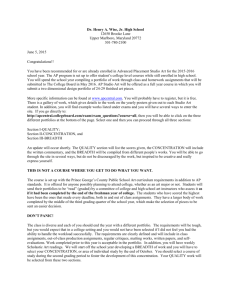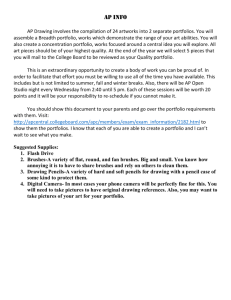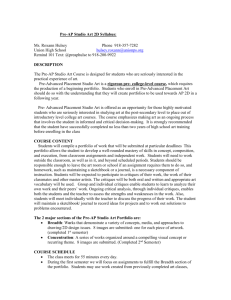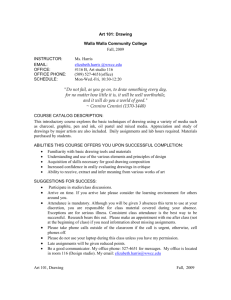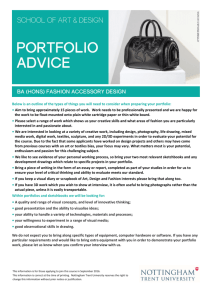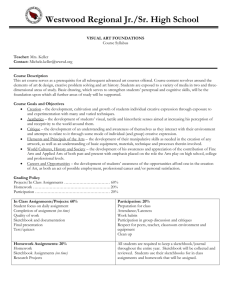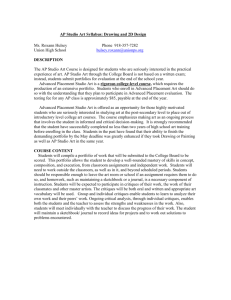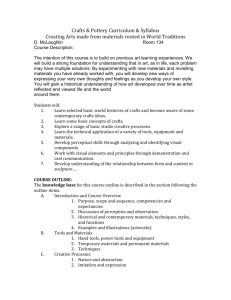Supply List - Effingham County Schools
advertisement
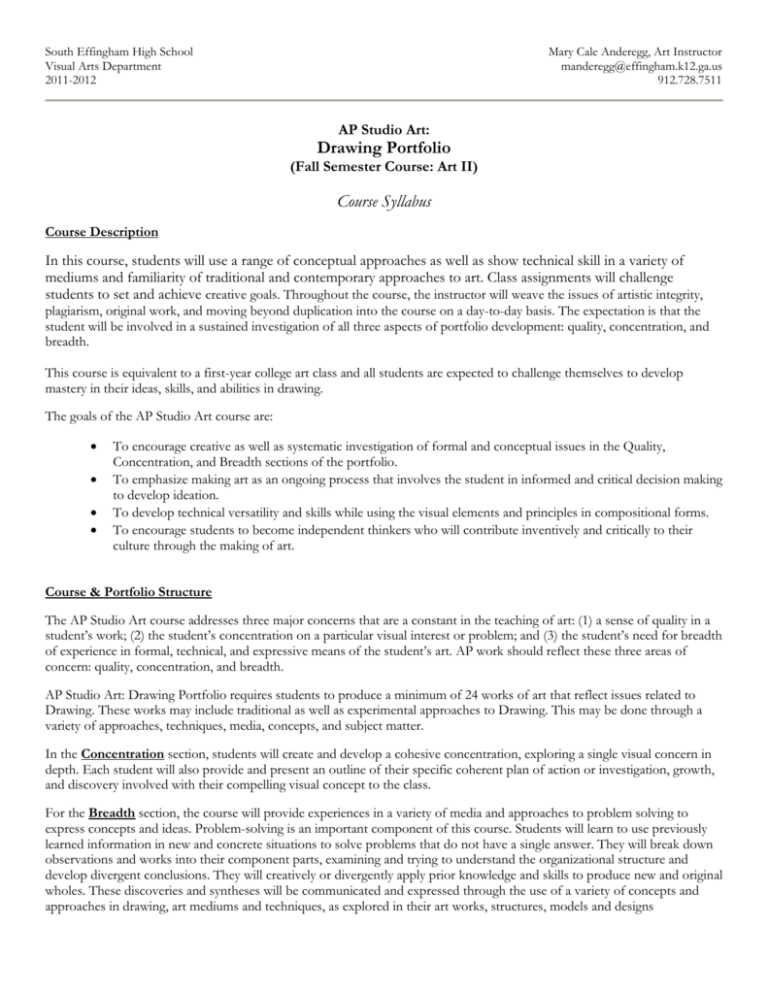
South Effingham High School Visual Arts Department 2011-2012 Mary Cale Anderegg, Art Instructor manderegg@effingham.k12.ga.us 912.728.7511 AP Studio Art: Drawing Portfolio (Fall Semester Course: Art II) Course Syllabus Course Description In this course, students will use a range of conceptual approaches as well as show technical skill in a variety of mediums and familiarity of traditional and contemporary approaches to art. Class assignments will challenge students to set and achieve creative goals. Throughout the course, the instructor will weave the issues of artistic integrity, plagiarism, original work, and moving beyond duplication into the course on a day-to-day basis. The expectation is that the student will be involved in a sustained investigation of all three aspects of portfolio development: quality, concentration, and breadth. This course is equivalent to a first-year college art class and all students are expected to challenge themselves to develop mastery in their ideas, skills, and abilities in drawing. The goals of the AP Studio Art course are: To encourage creative as well as systematic investigation of formal and conceptual issues in the Quality, Concentration, and Breadth sections of the portfolio. To emphasize making art as an ongoing process that involves the student in informed and critical decision making to develop ideation. To develop technical versatility and skills while using the visual elements and principles in compositional forms. To encourage students to become independent thinkers who will contribute inventively and critically to their culture through the making of art. Course & Portfolio Structure The AP Studio Art course addresses three major concerns that are a constant in the teaching of art: (1) a sense of quality in a student’s work; (2) the student’s concentration on a particular visual interest or problem; and (3) the student’s need for breadth of experience in formal, technical, and expressive means of the student’s art. AP work should reflect these three areas of concern: quality, concentration, and breadth. AP Studio Art: Drawing Portfolio requires students to produce a minimum of 24 works of art that reflect issues related to Drawing. These works may include traditional as well as experimental approaches to Drawing. This may be done through a variety of approaches, techniques, media, concepts, and subject matter. In the Concentration section, students will create and develop a cohesive concentration, exploring a single visual concern in depth. Each student will also provide and present an outline of their specific coherent plan of action or investigation, growth, and discovery involved with their compelling visual concept to the class. For the Breadth section, the course will provide experiences in a variety of media and approaches to problem solving to express concepts and ideas. Problem-solving is an important component of this course. Students will learn to use previously learned information in new and concrete situations to solve problems that do not have a single answer. They will break down observations and works into their component parts, examining and trying to understand the organizational structure and develop divergent conclusions. They will creatively or divergently apply prior knowledge and skills to produce new and original wholes. These discoveries and syntheses will be communicated and expressed through the use of a variety of concepts and approaches in drawing, art mediums and techniques, as explored in their art works, structures, models and designs The student’s best work will be included in the Quality section of the portfolio, which will be selected for excellence in concepts, composition, and execution of drawing. Each work will show mastery of varied media, techniques, approaches, concepts, and subject matter. Assignments & Projects The first part of this course will require students to create work for the breadth section of their Drawing Portfolio. Students will be given assignments that will guide them through various techniques, materials, concepts, and visual problems. Assignments will have clear due dates, and students will be required to meet them. Assignments given will help students develop skills, techniques, and ideas about a variety of issues in Drawing. The second part of the course will allow students more flexibility as they begin to develop their concentration section for their portfolio. Students will be given strict deadlines for completion of each work of art. Critiques will be held frequently, both as a group and on an individual basis. Homework & Sketchbooks It is expected that students spend a considerable amount of time outside the classroom working on assignments. Portfolios and sketchbooks should be taken home daily. Materials and tools may be checked out through the teacher. It is the student’s responsibility to meet deadlines by working in class and outside of class. It is critical to the artistic growth of the student that they devote time outside of class to their artwork. Doing out-of-class and at-home work reinforces skills, vocabulary, and higher level thinking models including sketchbook/visual journal and summer assignments. Additionally, a sketchbook will be required as an essential tool to assist the student in a successful 2D Design Portfolio. Students will use sketchbooks for planning works of art and brainstorming as well as journaling, planning, reflecting, and documenting artistic growth and direction of their studio art experiences. Students will include in their sketchbooks visual ideas, notes, photos, doodles, plans, short assignments, quick sketches, and various techniques. Sketchbook assignments will be given weekly and progress will be checked frequently. This will provide students with the opportunity to explore a variety of approaches to drawing. In addition to sketchbook work, students will be required to plan for projects and artworks outside of class. This reinforces skills, vocabulary and higher-level thinking modes, including sketchbook/visual journal and summer assignments. Homework, maintaining a sketchbook or journal, and work outside the classroom and beyond scheduled periods is necessary and is used throughout the course. Summer Assignments Assignments will be given to students to be completed over the summer prior to enrollment in the AP Studio Art course. These assignments will deal with the production of works of art as well as sketchbook explorations. Assignments will be checked in the first week of enrollment in the course, and are an important element in the exploration of a variety of artistic issues. Evaluation, Assessment, and Critique Assessment and critique are an integral part of the AP Studio process. Work will be evaluated through group and individual critiques with peers and faculty. Group critiques will take place both at the in-progress state of the work and after work has been completed, and will occur weekly. Students will demonstrate understanding of vocabulary in classroom discussions and critiques and are reminded to analyze the following during a critique: composition, execution (technique), and concept. Successes and areas of improvement will be discussed with teacher and with their peers. Individual critiques will take place in the form of dialogue or written feed-back. Individual critiques will focus on assessment of strengths and weaknesses in student work and further development of works. Individual critiques will be both scheduled and spontaneous, as students work in the studio. Students will learn skills in self-assessment and art criticism to facilitate this progress. The College Board’s AP Studio Art rubric, which is distributed separately, provides the grading criterion which is used for scoring Drawing Portfolios. This rubric will be used as a tool for assessment and evaluation of student work. Additional objectives and ideas will be assessed as needed. Grading Percentages 9-Week Percentages Project Grades – 55% -Projects, Exams, Artworks Classwork Grades- 45% -Planning Sketches, Sketchbook Entries, Quizzes, Daily Activities, Written Assignments, Work Ethic Grades, Participation in Critiques, etc. Homework Grades- 10% -Any classwork assigned to be completed outside of class time Late Work Policy For every day that an assignment is late, 5 points will be deducted from the students earned score on that assignment. Absences If a student is absent when a project is turned in, it is the student’s responsibility to turn in the work when they return. If a student is absent when a test is given, it is the student’s responsibility to schedule an appointment with the teacher to make up the test. This applies whether an absence was excused or unexcused. Artistic Integrity If you submit work that makes use of photographs, published images, and/or other artists’ works, you must show substantial and significant development beyond duplication to ensure personal artistic ownership in the work. Plagiarism, using an image (even in another medium) that was made by someone else, is unethical and it will not be allowed in this course. Students will review both the AP poster and the Course Description during a class discussion on artistic integrity, plagiarism, original work, and moving beyond duplication. This will remain a constant topic of discussion throughout the course. Supply List 1. Students will be required to keep a PORTFOLIO, approximately 22” x 28” in size. 2. A SKETCHBOOK, approximately 8 ½” x 11”, spiral bound with pockets. 3. #2 Pencils 4. Eraser 5. A plastic cup for painting Semester Schedule: Semester I (Fall) AP Studio Art: Drawing Portfolio Focus: Creating Breadth 18 Weeks/5 days a week/1.5 hours per day Week Weeks 1 & 2 Topics/Concepts Course Requirements AP Exam Requirements & Portfolio Components Artistic Ingetrity: Students will review both the AP poster and the Course Description during a class discussion on artistic integrity, plagiarism, original work, and moving beyond duplication. Review of Prerequisite Work Contour Line Drawing Positive and Negative Space Drawing negative space Expression with Line Gestural Line Qualities Assessment Evaluation of Prerequisite Work Sketchbook (due every Tuesday) Week 1- None -Individual Critique -Written Reflection Evidence of exploration due by end of first week, showing contour line practice and line styles. -Individual Critiques A finished piece, using line as the main element, due by the end of week 2 (Breadth). Week 2- Draw the interior of your bedroom. Fill the entire page. On a separate page, think about how it represents you, even though you are no in the drawing. Write a reflection based upon that idea. (due Tuesday of second week) -Individual and Group Critique Expressive Line Drawing/Still Life AND Negative Space Drawing (Charcoal) due by end of second week (Breadth) -Individual and Group Critiques Weeks 3 & 4 Tonal Value Changes in Drawing Composition & Design Concentration Topics “Kitchen Utensils” Project due by end of fourth week (Breadth) -Individual and Group Critiques Bicycle Drawing, in tonal values, due by the end of the fourth week(Breadth) -Individual and Group Critiques List of 10 concentration topics due by end of fourth week -Individual and Group Discussion Week 5 Hatching and Crosshatching Composition and Design Pen/Brush and Ink Pen & Ink due by the end of the fifth week. (breadth) Week 3- Open entry of your choice, showing value. Week 4-. Cover at least four pages with charcoal. Make a variety of marks; smudge the charcoal, experiment with erasure. Draw a favorite object from your house. Do not place it in the middle of the picture plane! Week 5- Draw a still life of geometric forms. Include at least one sphere, cube, cone, and pyramid. Add value by using crosshatching. This should be done in pen. Remember to activate the picture plan, so don’t draw it too small Weeks 6 & 7 Viewpoint and Composition Linear Perspective Foreshortening Architectural Rendering due by the end of the seventh week. -Individual and Group Critiques Foreshortening/Exaggerated Viewpoint project due by the end of the seventh week. -Individual and Group Critiques Week 6- Find an object you use everyday. Create a composition in your sketchbook that makes it seem interesting. Draw it in graphite, and shade according to what you see. Be sure to do something with the negative space! Week 7- Draw the contents of your purse, book bag, or pocket. Arrange the items in an interesting fashion. Draw them, filling the entire page. Experiment with line and value. Week 8 Color Theory in Drawing Color Interaction Soft Pastels & Oil Pastels Concentration Topics Color Still Life in pastels due by the end of the eighth week(breadth) -Individual and Group Critiques Second list of concentration topics due by end of eighth week. -Individual and Group Discussion Weeks 9 & 10 Color Schemes Monochromatic “Who Ate My Lunch” Still Life Project/Cropped Viewpoint due by the end of the tenth week (breadth) Warm & Cool -Individual and Group Critiques Acrylics & Oils Warm and Cool Colors Project due by end of tenth week (breadth) Mark Making in Painting -Individual and Group Critiques Week 8- Draw your foot at least five times using sharpie marker. Experiment with different widths and take advantage of the strength and rich textures these pens permit. Overlap to create an interesting, full composition! Week 9- Select a work by a famous artist. Paste a copy into your sketchbook. Make three studies of the work. Make a drawing using only line. Make one showing only the values (no line). Make another showing only the colors (crayon, colored pencil, and marker). Week 10- Draw the view out a window in your home. Do this in a monochromatic color scheme. Weeks 11& 12 Scale Surrealism Scale Change project due by end of twelfth week (breadth) -Individual and Group Critiques Week 11- Design a room interior based on a specific color scheme. Fill the entire page. Week 12: Do a drawing based on exaggerating proportion. Fill the entire page. Week 13 Mixed Media/Deconstruction Collage Social and Political Issues in Art Week 14 Facial/Figure Proportion Concentration Topics Mixed Media/Deconstruction Collage due by end of 13th week (breadth) -Individual and Group Critiques Self-Portrait due by the end of the fourteenth week -Individual and Group Critiques Week 13: Using the letters of your name, create a design, filling the entire page. Week 14- Do a composition based upon a social or political issue. Fill the entire page. “Story Board” or Plan of Concentration Development Weeks 15 & 16 Figure Drawing Gesture Drawing Figure/Ground Relationship Portraiture Figurative Composition due by end of fifteenth week -Individual and Group Critique Composition w/ Faces due by end of sixteenth week Week 15- Do ten drawings of your hands. Fill at least two whole pages. Week 16- Draw a receding checkerboard or chess set using perspective drawing. -Individual and Group Critique Week 17 Open week for completing all work and preparing portfolio for review. Individual and Group Discussion Week 17- Do a selfportrait in India ink, focusing on expressive lines. Use a brush. Fill the entire page. Week 18 Breadth Portfolio due as a PowerPoint presentation Breadth Portfolio due by end of eighteenth week Concentration topic due by end of eighteenth week Group Critique Week 18- Rework a sketchbook entry that you did not do well on. Written Reflection Concentration topic due by end of eighteenth week. Semester Schedule: Semester II (Spring) AP Studio Art: Drawing Portfolio Focus: Exploring Concentration Week 18 Weeks/5 days a week/1.5 hours per day Topics/Concepts Assessment Week 1: 1/6/11 (2 days) Discussion of concentration topics and review of initial ideas. Week 2: 1/10/11 Plan of Action development for concentrations Week 3: 1/16/11 (4 days) Week 4: 1/24/11 Week 5: 1/31/11 Two works due by end of third week Sketchbook (due every Tuesday) Independent Entry #1 -Individual and Group Critique Individual development of concentrations emphasizing process and materials. Individual development of concentrations emphasizing process and materials. Two works due by end of 5th week Independent Entry #2 -Individual and Group Critique -Written Reflection Week 6: 2/7/11 Week 7: 2/14/11 Week 8: 2/22/11 (4 days) Week 9: 2/28/11 Week 10: 3/7/11 (Fashion Show) Week 11: 3/17 (PTC, St. Patty’s, 2 days) Week 12: 3/21 Individual development of concentrations emphasizing process and materials. Two works due by end of 7th week Individual development of concentrations emphasizing process and materials. Two works due by end of 9th week Independent Entry #3 -Individual and Group Critique Independent Entry #4 -Individual and Group Critique -Written reflection Individual development of concentrations emphasizing process and materials. Two works due by end of twelfth week -Individual and Group Critique Concentration Portfolio due by the end of the 12th week. Independent Entry #5 Week 13: 3/28 (GHSGT) Finalization of portfolio, focusing on revision Week 14: 4/4 Written commentary first draft due by end of week 13. Two works due by end of fourteenth week Independent Entry #7 -Individual and Group Critique Written commentary first draft due by end of week 13. -Individual and Group Discussion Week 15: 4/11 Week 16: 4/18 (4 days) Spring Break Finalization of portfolio, focusing on revision Quality Portfolio pieces chosen and submitted for matting by the end of week 15 Two works due by end of 16th week Independent Entry #8 -Individual and Group Critique Final written commentary due by end of week 15. -Written Reflection Final written commentary due by end of week 15 -Group Discussion Quality Portfolio chosen for matting by end of 15th week. -Individual and Group Discussion Week 17: 5/2 AP DEADLINE WEEK! AP Portfolio materials assembled and delivered. AP Breakfast for Parents, Faculty, and Staff Week 18: 5/19 Sketchbooks due for a grade Week 19: 5/16 (LEOCT) Presentations of Portfolios Week 20: 5/23 (Senior Week, 3 days) All photos and portfolio components done Independent Entry #9 MAY 6 – PORTFOLIOS SUBMITTED BY THE END OF CLASS! PowerPoint presentations of complete portfolio with statements submitted on CD for final grade Teacher References/Resources AP Central apcentral.collegeboard.com AP Studio Art Poster. New York: The College Board, 2008 AP Studio Art Teachers Guide. New York: The College Board, 2008 Sketchbook due with written reflection
